

WILF To know how unicellular living things are able to carry out life processes and be able to say how they are different from animal and plant cells Starting point Can you remember what the difference between a multicellular organism and a unicellular organism is Write it down as a ID: 1034835
Download Presentation The PPT/PDF document "WALT: Describe what unicellular living ..." is the property of its rightful owner. Permission is granted to download and print the materials on this web site for personal, non-commercial use only, and to display it on your personal computer provided you do not modify the materials and that you retain all copyright notices contained in the materials. By downloading content from our website, you accept the terms of this agreement.
1. WALT: Describe what unicellular living things areWILF: To know how unicellular living things are able to carry out life processes, and be able to say how they are different from animal and plant cells.Starting point.....Can you remember what the difference between a multi-cellular organism and a unicellular organism is? Write it down as a sentence.
2. Unicellular organismMulticellular organismA living thing made up of only ONE cell.A living thing made up of MORE than ONE cell.Examples of unicellular organismsExamples of multicellular organisms
3.
4. Unicellular organisms are everywhere – in soil, water and even on your skin right now!What clue does this give you about their size?
5. This is an amoeba – they are single celled organisms that have no definite shape.They move by making their cytoplasm flow along.They live at the bottom of freshwater streams and ponds.Amoeba
6.
7. NucleusCell membraneCytoplasmContractile vacuoleFood vacuoleAmoeba
8. Euglena
9. Contractile vacuoleCell membraneChloroplastNucleusMitochondriaCytoplasmFlagellumLight spotEuglena
10. EuglenaEuglena is a single-celled microscopic algae. It is a unique organism that can accumulate nutrients by photosynthesis and move like an animal by twisting itself. The scientific name of Euglena evolved from the Latin eu that means beautiful and glena that means eyes.
11. Paramecium
12. Macro NucleusMicro NucleusCytoplasmFood vacuoleMouth grooveMembraneCilia hairsContractilevacuoleAnal poreParamecium
13. A contractile vacuole gradually fills up with water and then empties. Living things that live in water need these so that they don’t swell up with too much water – which could make it burst!!
14. Paramecium is a small single-celled organism that is plentiful in freshwater ponds. It swims, rotating slowly, and often changing its direction. Under suitable conditions it may reproduce by dividing two or three times a day and so large numbers may build up. It belongs to the group of organisms called Protozoa. Most of these are microscopic with over 80,000 different species identified.Paramecium
15. Does it have.......?Animal cellPlant cellAmoebaParameciumEuglenaA nucleusCytoplasmMitochondriaCell membraneChloroplastsVacuoleCell wallPut a tick or cross in each box to compare the cells
16.